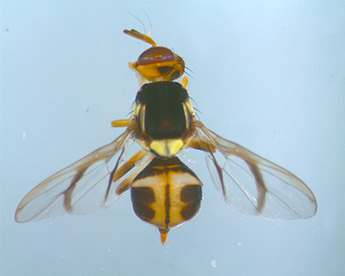White Striped Fruit Fly
Pest Profile


The general appearance of B. albistrigata resembles an oriental fruit fly, but B. albistrigata differs from it by the wing pattern and the coloration pattern on the thorax and abdomen (Figure 1). The wing has a brown mark along the front edge which becomes faint at mid length, and then reappears as a light spot at the tip; there are two brown stripes going across the wing, one at the base and one at mid length. The thorax has a yellow scutellum which may have a dark triangle mark anteriorly. The abdomen has a dark stripe down the middle, flanked by two broader stripes at the sides.
Distribution
Bactrocera albistrigata occurs on Christmas Island (a territory of Australia), the Andaman and Nicobar Islands (India), Indonesia (Java, Lombok, Sulawesi, Sumatra), peninsular Malaysia, southern Thailand, and probably northern and western Irian Jaya (Indonesia) (based on misidentifications as B. frauenfeldi).
Life Cycle
No information is available on developmental parameters. Therefore, it is recommended that life cycle projections be based on the known degree day values for the most closely related species, namely oriental fruit fly, Bactrocera dorsalis.
Host
Bactrocera albistrigata has been recorded from the fruit of guava (Psidium guajava), mango (Mangifera indica), carambola (Averrhoa carambola), tropical almond (Terminalia catappa), Singapore almond (Terminalia procera), jackfruit (Artocarpus heterophyllus), clove (Syzygium aromaticum), watery rose-apple (Syzygium aqueum), rose apple (Syzygium jambos), Malay-apple (Syzygium malaccense), water apple (Syzygium samarangense), Syzygium sp., and a number of Asian trees occasionally planted as ornamentals [Aglaia argentea, Alexandrian laurel (Calophyllum inophyllum), badhara bush (Gmelina elliptica), beach gardenia (Guettarda speciosa), bakula (Mimusops elengi), kojbar (Neisosperma oppositifolium), mast tree (Polyalthia longifolia), and Scolopia spinosa] (Allwood et al. 1999, Ranganuth and Veenakumari 1999, Ranganuth et al. 1998, White and Elson-Harris 1992, White and Hancock 2004).
Lure:
Males are attracted to cuelure (attractant for male fly), and therefore can be found on melon fly traps.
Economic Importance to California
In California, the 2007 gross value of guava was $621,100 (USDA NASS 2008). Carambola and mango are grown in some small plots in southern California, but the dollar values of these are apparently too small to be reported. The remainder of the hosts are not known to be grown in California for commercial fruit production.
Fact Sheets
Literature Cited:
- Allwood, A. J., A. Chinajariyawong, R. A. I. Drew, E. L. Hamacek, D. L. Hancock, C. Hengsawad, J. C. Jipanin, M. Jirasurat, C. Kong Krong, S. Kritsaneepaiboon, C. T. S. Leong, and S. Vijaysegaran. 1999. Host plant records for fruit flies (Diptera: Tephritidae) in southeast Asia. Raffles Bulletin of Zoology, Supplement 7, 92 pp.
- Ranganuth, H. R. and K. Veenakumari. 1999. Notes on the dacine fruit flies (Diptera: Tephritidae) of Andaman and Nicobar Islands – II. The Raffles Bulletin of Zoology 47(1): 221-224.
- Ranganath, H. R., K. Veenakumari, and S. Ramani. 1998. A short note on the distribution and host plants of Bactrocera (Bactrocera) albistrigata de Meijere (Diptera: Dacinae: Tephritidae) in Andaman and Nicobar Islands. Malayan Nature Journal 52(3-4):161-162.
- USDA NASS. 2008. California County Agricultural Commissioners’ Data, 2007. United States Department of Agriculture. National Agricultural Statistics Service. California Field Office, Sacramento. 78 pp.
- White, I. M. and M. M. Elson-Harris. 1992. Fruit Flies of Economic Significance: Their Identification and Bionomics. CAB International. Oxon, UK. 601 pp.
- White, I. M. and D. L. Hancock. 2004. Fauna Malesiana – Interactive key for dacine fruit flies (Diptera: Tephritidae: Dacini). Version 1.0.
